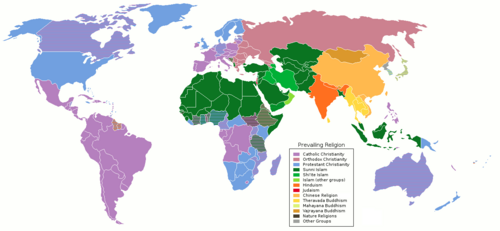Jeroviapy
| Jeroviapy | |||
|---|---|---|---|

| |||
| Umi jeroviapy tuichavéva ñemohenda | |||

Jeroviapy, térã ajengatu, niko yvypóra jegueroviapy kuéra oporombojepokuaáva oporomboguata hag̃ua imbo'epýre ha upéicha ijapaite avano'õre ha arandupýre. Oĩ jeroviapy opaichagua, upéarõ ojehecha heta jegueroviapy aty ha jeroviahakuéra ojoavýva.[nota 1] Ndaipóri ramo jepe ñe'ẽpeteĩ he'i hag̃ua mba'épa he'iseite jeroviapy,[1][2][3] karai Bernard Lonergan ohechakuaa jeroviapy ha'eha niko avano'õ remiandu, rembiasa, jegueroviapy, jepokuaaha ha jerovia rembiapo, ha ãva rupi umi ojeroviáva ombohovái iñeimo'ã arapýre ha ijokuaa itupãre térã ijeroviaháre.[4]
Oĩ heta jeroviapy omohenda imbo'epyrã, upéicha ohechauka umi ojeroviávape mba'éichapa heko porã va'erã ha mba'éichapa hembiapo va'erã opyta hag̃ua jeroviapy ñembyatýpe, upéicha avei ojehecha jeroviapykuéra ojapo henda marangaturã (tupão, tekove marangatu róga, opy, paje róga) térã imbo'epy ojejuhu aranduka marangatúpe (Hesu rape oreko iñaranduka marangatu héra Biblia ha Islã oreko Korã, techapyrãme). Jeroviapykuéra ojapo iñembyatyrã, umi ojeroviáva oñembyatyhápe oikuaave hag̃ua ijeroviapýre térã omomba'eguasu hag̃ua ijeroviahápe. Jeroviapykuéra omombe'u avei mba'éichapa oñepyrũ tekove ha arapy, térã omombe'u mba'érepa yvypóra oiko ko Yvýpe.
Oĩ ñehesa'ỹijo he'íva ikatu oĩha amo 4200 jeroviapy Yvy jerekuévo ha hetaveiterei ko'ãga ndaiporivéima ojeroviáva hese.[5][6] Ñehesa'ỹijo ojejapo akue ary 2012-me heta tetãme ohechauka 59 % opaite tekovekuéragui «ijeroviapyha» ha 36 % ndorekói jeroviapy (umíva ndive oĩ 13 % ndojeroviái Tupãre).[7]
Heta jeroviapýpe, peteĩ umi jegueroviapykuéra mba'eguasuvéva apytépe oĩ pe jegueroviapy he'íva oĩha peteĩ térã heta tupã (Hesu rape he'i oĩha Ñandejára ha Islã he'i oĩha Ala, techapyrãme), umi jeroviapýpe tupã niko tekove guasu opamba'e ipoguýpe orekóva, upe ojapo opamba'e, upe ojejerovia va'erã hese ha oñemomba'eguasuva'erã chupe. Oĩ jeroviapy he'íva oĩha peteĩ Tupã mante ha ndaipóri ijeroviaha ambuéva, upéicha avei oĩ jeroviapy he'íva oĩha Tupã opaichagua, techapyrãme peteĩ oñangarekóva yvýre ha ambuéva oñangareko ýre, peteĩ oñangareko umi omanóvare ha ambuéva oñangareko umi ñorairõme ohóvare. Heta jeroviapýpe he'i oĩha mba'e pokatu ambuéva, umíva apytépe oĩ aña, tupã remimbou ha tupã rymba, póra iporãva ha póra iñañáva.
Marandu'i
[jehaijey | emoambue kuatia reñoiha]- ↑ Si bien la religión es difícil de definir, Clifford Geertz propuso un modelo estándar de la religión, quien simplemente lo llamó un «sistema cultural» (Clifford Geertz, Religion as a Cultural System, 1973). Una crítica del modelo de Geertz por Talal Asad categorizó la religión como «una categoría antropológica». (Talal Asad, The Construction of Religion as an Anthropological Category, 1982).
Mandu'apy
[jehaijey | emoambue kuatia reñoiha]- ↑ «Myth 1: All Societies Have Religions». 50 Great Myths of Religion. Wiley-Blackwell. 2013. pp. 12–17. ISBN 9780470673508.
- ↑ Before Religion: A History of a Modern Concept. Yale University Press. 2013. pp. 152. ISBN 030015416X. «Although the Greeks, Romans, Mesopotamians, and many other peoples have long histories, the stories of their respective "religions" are of recent pedigree. The formation of "ancient religions" as objects of study coincided with the formation of religion itself as a concept of the sixteenth and seventeenth centuries.»
- ↑ 'Religion' and the Religions in the English Enlightenment. Cambridge: Cambridge University Press. 1990. pp. 1. ISBN 0521892937. https://archive.org/details/religionreligion00harr. «That there exist in the world such entities as 'the religions' is an uncontroversial claim...However, it was not always so. The concepts 'religion' and 'the religions', as we presently understand them, emerged quite late in Western thought, during the Enlightenment. Between them, these two notions provided a new framework for classifying particular aspects of human life.»
- ↑ Lonergan, Bernard (1988). «Religión». Método en Teología. Salamanca: Sígueme. ISBN 84-301-1053-4.
- ↑ The Everything World's Religions Book: Explore the Beliefs, Traditions and Cultures of Ancient and Modern Religions, page 1 Kenneth Shouler - 2010
- ↑ «Un planeta con 4.200 religiones vivas e incalculables creencias ya extinguidas». Materia (25 de diciembre de 2013). Archivado desde el original, el 22 de agosto de 2014.
- ↑ «Global Index of Religiosity and AtheismArchive copy». WIN-Gallup International (27 de julio de 2012). Archivado desde el original, el 6 de septiembre de 20122013-01-17. Ojehechákuri árape: 24 de agosto de 20122020-11-08.
